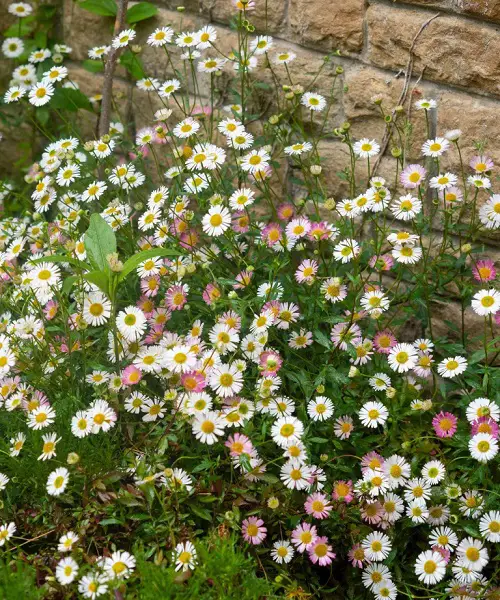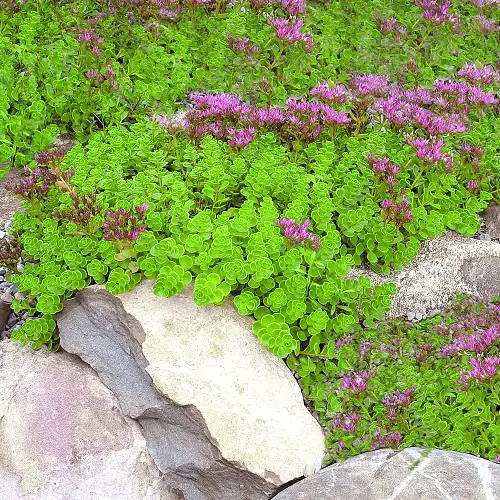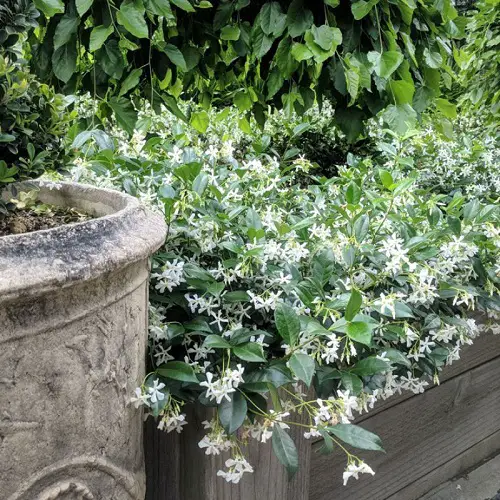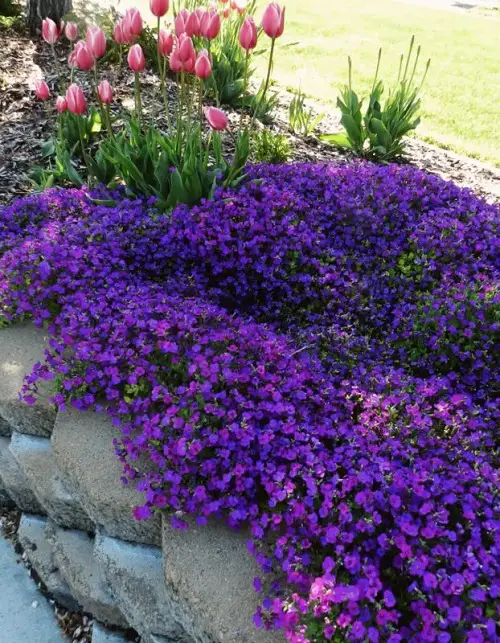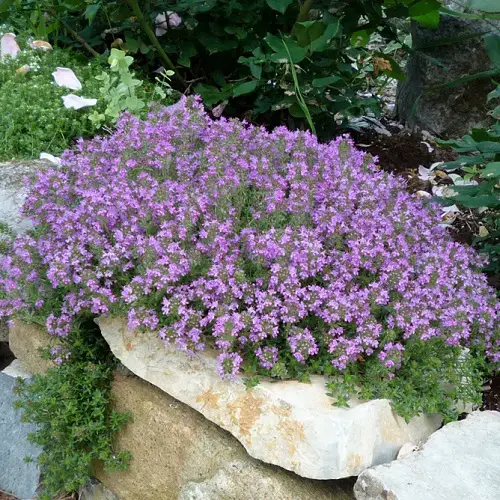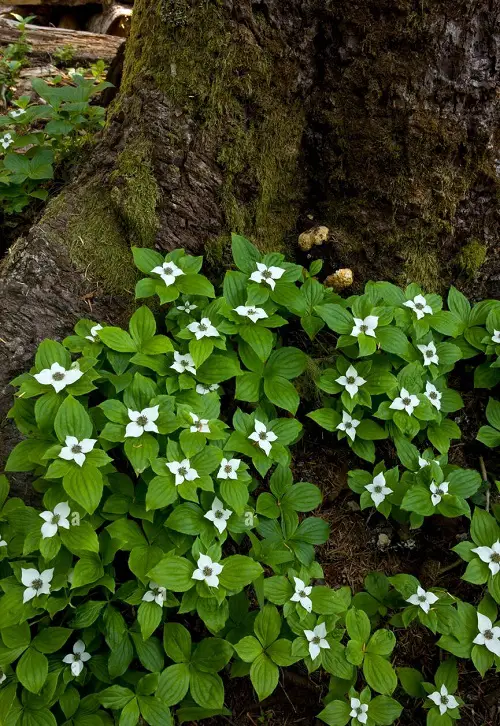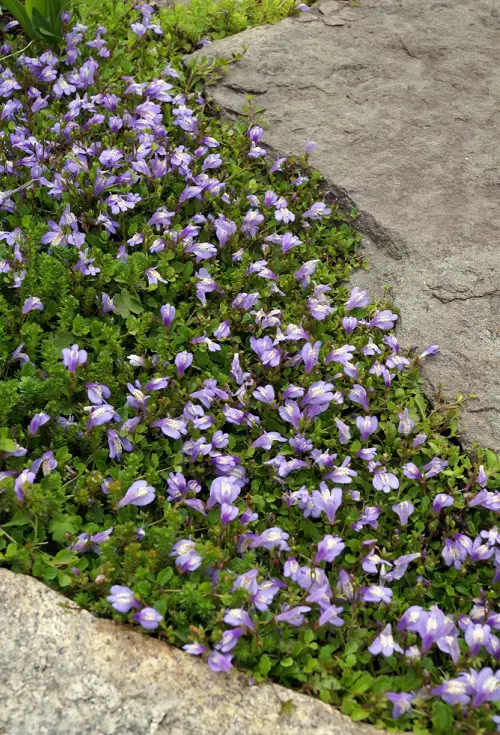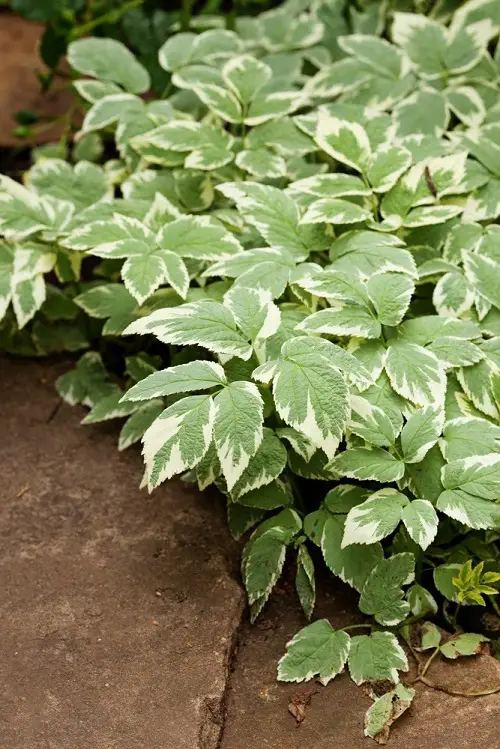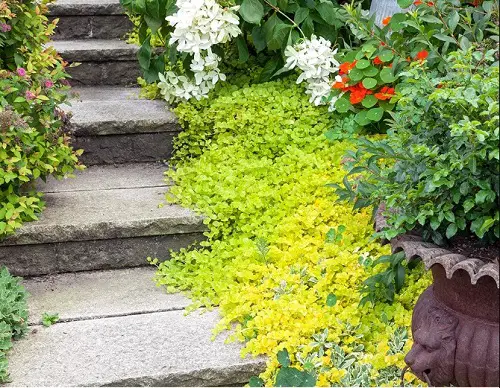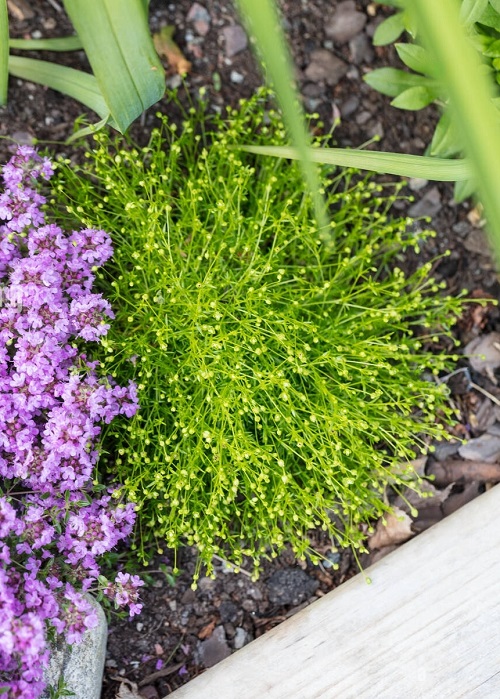Check out the list of the best Fast Growing Ground Cover Plants that provide quick coverage for your outdoor spaces.
If you’re looking to quickly fill in empty spaces and add vibrancy to your garden, these Fast Growing Ground Cover Plants are the perfect solution. These resilient plants spread rapidly, creating lush carpets of green in no time!
Fast Growing Ground Cover Plants
1. Mexican Daisy
Botanical Name: Erigeron karvinskianus
USDA Zones: 6-9
Mexican Daisies are these cool flowering plants that can double as a living carpet for your garden! They creep along the ground, forming a pretty layer of green leaves with little daisy flowers that pop up all the time.
2. Bugleweed
Botanical Name: Ajuga reptans
USDA Zones: 4-10
Bugleweed’s kind of like a tiny, evergreen champion. It spreads out fast with pretty purple flowers that bloom in spring, forming a thick rug over the ground. This little trooper thrives in both shade and sun, choking out weeds as it goes. Bugleweed can spread anywhere from 6 to 18 inches in a year.
3. Sedum
Botanical Name: Sedum ‘stonecrop’
USDA Zones: 4-9
Super low-key, these succulent plants come in all sorts of neat colors and textures, from green to blue to even burgundy. They creep along the ground, forming a lush little mat. The best part? Sedums don’t mind hot, dry places and barely need any watering.
4. Lamium Flowers

Botanical Name: Lamium maculatum
USDA Zones: 3-8
Lamium loves to spread, forming a pretty carpet of green leaves that keeps weeds at bay. Just be sure to give them a little room. These cheerful bloomers come in shades of white, yellow, and purple, popping up all through the season in clusters that look like little hoods.
5. Asiatic Star Jasmine
Botanical Name: Trachelospermum jasminoides
USDA Zones: 7b-10
Asiatic Star Jasmine is the MVP of ground covers! This fast-growing vine loves to sprawl out, blanketing the ground with its shiny green leaves.
It’s pretty low maintenance, too; just water it regularly until it gets established and give Asiatic Star Jasmine a little trim every now and then to keep it tidy.
6. Herbaceous Clematis
Botanical Name: Clematis – Viticella Group
USDA Zones: 4-11
These vining Clematis varieties spread quickly to fill empty areas. They’re not fussy either, happy in the sun or dappled shade. Come summer, they’ll surprise you with beautiful bell-shaped or starry flowers in shades of purple, blue, or white.
Plus, they die back in winter, making room for new growth next spring.
7. Rockcress
Botanical Name: Aubretia
USDA Zones: 6-8
Rockcress is a little flowering perennial that forms a charming green mat that bursts into colorful blooms come spring. Think tiny purple, pink, or white flowers smothering the foliage—a real showstopper! It is a fast-grower and will grow 6-8 inches per year.
8. Sweet Woodruff
Botanical Name: Galium odoratum
USDA Zones: 4-9
As the Sweet Woodruff plant spreads quickly, it creates a lush green carpet over the ground that releases a sweet fragrance from its foliage. It’s perfect for softening bare spots under trees, adding texture to shady borders, or creating a natural pathway.
9. Blue Plumbago
Botanical Name: Plumbago auriculata
USDA Zones: 5-9
Blue Plumbago is a stunning ground cover that gives a double dose of beauty! It forms a low-growing carpet of rich green leaves that spreads gently over time.
The real stars of the show are the flowers. From late summer right into fall, blue plumbago gives vibrant blue blooms that resemble phlox.
10. Caraway Thyme
Botanical Name: Thymus herba-barona
USDA Zones: 4-9
Caraway thyme is a culinary herb that’s also a gorgeous ground cover! This little charmer creeps along the ground, forming a fragrant mat of dark green, glossy leaves. But the best part is the scent! Just like caraway seeds, its leaves have a strong, licorice-like aroma that fills the air.
11. Bunchberry
Botanical Name: Cornus canadensis
USDA Zones: 2-7
Bunchberry is a slow-growing plant that typically forms a carpet-like mat. Bunchberry is found in acid soils, bogs, and upland slopes in Asia and from Greenland to Alaska and south as far as Maryland, New Mexico, and California.
12. Creeping Mazus
Botanical Name: Mazus reptans
USDA Zones: 5-8
Creeping mazus is a tiny powerhouse, perfect for sunny spots in your garden! This fast-spreading perennial forms a dense, green carpet that stays pretty throughout most of the year. In spring and summer, it bursts into bloom with clusters of adorable little purple-blue flowers.
13. Ground Elder
Botanical Name: Aegopodium podagraria
USDA Zones: 3-8
Hold on there! Ground elder is a bit of a double-edged sword. While it can form a nice carpet of foliage, it’s actually a weed that’s considered an invasive plant in many areas. Here’s the deal–Ground elder spreads with sneaky runners, easily taking over your garden and choking out other plants.
14. Trailing Periwinkle

Botanical Name: Vinca minor
USDA Zones: 7-9
Trailing Periwinkle is a lovely ground cover if you’re looking for a low-key and pretty addition for the garden. In spring, it explodes with cheerful lavender-blue flowers that bloom amongst the leaves. It can easily grow 6-12 inches each year.
15. Fern Moss

Botanical Name: Thuidium delicatulum
USDA Zones: 5-9
Fern moss is a low-growing, non-flowering plant. It isn’t technically a moss but creates a lush, soft carpet with fern-like fronds. Fern moss thrives in damp, shady areas, so it’s perfect for growing under trees or in pathways that don’t get much sun.
16. Japanese Spurge
Botanical Name: Pachysandra terminalis
USDA Zones: 4-8
While the tiny white flowers it produces in spring are pretty subtle, the showstopper is the lush, low-growing foliage. Japanese Spurge is a tough cookie, tolerating shade, drought, and even neglect once established.
17. Wintercreeper
Botanical Name: Euonymus fortunei
USDA Zones: 5a-9a
Wintercreeper is a versatile ground cover that can sprawl out to create a lush green carpet, perfect for sunny or shady areas. You can also train it to climb walls, fences, or trellises.
18. Creeping Wire Vine
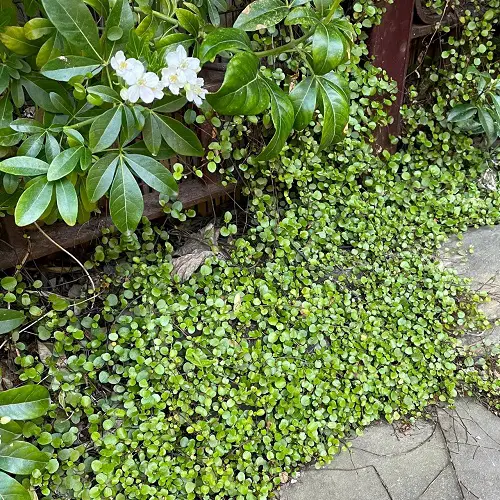
Botanical Name: Muehlenbeckia axillaris
USDA Zones: 7-10
The Creeping Wire vine is a tough plant that has abundant foliage. It is a good choice for slopes as its dense root system helps prevent erosion. Just be aware that it can be a bit too enthusiastic sometimes, so you’ll need to trim it every now and then.
19. Crown Vetch
Botanical Name: Securigera varia
USDA Zones: 3-9
Crown Vetch is a trailing vine with pretty, fern-like leaves that spread quickly, forming a dense green carpet. It bursts into bloom with clusters of pink or white pea-like flowers in the summer months.
20. English Ivy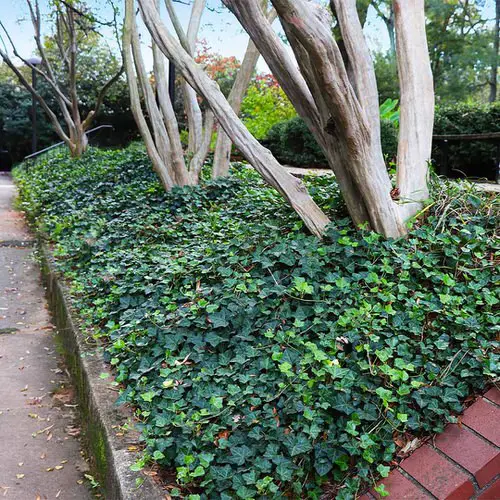
Botanical Name: Hedera helix
USDA Zones: 4-13
English ivy is a rapidly growing ground cover that is widely used on sloped areas due to its aggressive nature. It is commonly used to cover walls, fences, or expansive areas. Unlike many ground covers, English ivy thrives in shady areas, making it perfect for those dark corners under trees.
21. Creeping Jenny
Botanical Name: Lysimachia nummularia
USDA Zones: 4-9
Creeping Jenny can be a bit of a spreader, and while that’s great for filling in bare spots, it can also spread too much and try to take over unwanted territory. Just give it a trim, and you’ll be okay.
22. Irish Moss
Botanical Name: Sagina subulata
USDA Zones: 4-8
Irish moss isn’t actually a true moss, but it might fool you! This cool little ground cover forms a dense, green carpet that looks and feels soft and mossy underfoot. It doesn’t need constant watering once established and requires minimal fuss. Plus, it can tolerate light foot traffic.
23. Wedelia

Botanical Name: Wedelia
USDA Zones: 7-11
Wedelia is a low-growing perennial plant that forms a dense mat of trailing stems. It’s a fast-growing sun-loving plant with cheerful yellow daisy-like flowers. Wedelia thrives in almost any soil and tolerates sun or shade.
24. Lantana

Botanical Name: Lantana camara
USDA Zones: 7-11
Lantana is a low-growing perennial plant with trailing or mounding growth habits. It produces clusters of small, tubular flowers that are highly attractive to butterflies and other pollinators. Lantana can also tolerate heat and drought. Here are some ideas to help you out.


